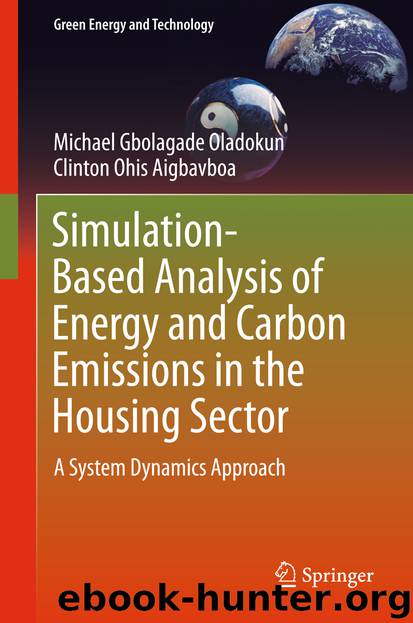Simulation-Based Analysis of Energy and Carbon Emissions in the Housing Sector by Michael Gbolagade Oladokun & Clinton Ohis Aigbavboa

Author:Michael Gbolagade Oladokun & Clinton Ohis Aigbavboa
Language: eng
Format: epub
Publisher: Springer International Publishing, Cham
Model
Unstandardised coefficients
Standardised coefficients
t
Sig.
B
Std. error
Beta
1
(Constant)
−3.436E8
4,538,500.746
−75.712
.000
Population
.067
.017
.056
3.886
.000
Time
182,057.612
2746.898
.947
66.278
.000
Dependent variable: Households
(Source: [48])
4.8 Summary
The SD approach was selected as an appropriate modelling platform for the research reported in this book. The chapter then discussed the SD approach in full, starting with the historical overview of the approach. The chapter underpinned the SD approach both in theory and philosophy. As such, the SD approach was identified within the frame of the pragmatic paradigm. This indicates that any study involving SD falls within the purview of qualitative and quantitative research strategies. The chapter also succeeds in showing the SD approach as a multidisciplinary modelling method that has been used in many fields. Additionally, the chapter discussed the four stages involved in the SD modelling process, namely problem identification and definition; system conceptualisation; model formulation and behaviour analysis; model testing and validation, and policy formulation and analysis stages. Furthermore, DYNAMO, Powersim, STELLA/iThink, AnyLogic, and Vensim, some of the software under which SD can be implemented, were briefly discussed. The chapter indicated that Vensim was used as the modelling software for the book. This is because of its flexible graphical representations which aid its clarity in presenting the CLDs as well as its ability to incorporate optimisation. The discussion of the methods used in the development of the relationships (algorithms) among the model variables concludes the chapter. These methods include the use of SD functions within the Vensim software, regression analysis, and SEM as well as other established equations such as those provided in SAP algorithms. The next chapter discusses the application of the SD approach for modelling and simulating the energy and carbon emissions problem in housing using the UK housing sector as example.
Download
This site does not store any files on its server. We only index and link to content provided by other sites. Please contact the content providers to delete copyright contents if any and email us, we'll remove relevant links or contents immediately.
Kathy Andrews Collection by Kathy Andrews(11730)
The remains of the day by Kazuo Ishiguro(8822)
Paper Towns by Green John(5089)
Spare by Prince Harry The Duke of Sussex(5072)
Industrial Automation from Scratch: A hands-on guide to using sensors, actuators, PLCs, HMIs, and SCADA to automate industrial processes by Olushola Akande(4980)
The Body: A Guide for Occupants by Bill Bryson(4974)
Machine Learning at Scale with H2O by Gregory Keys | David Whiting(4179)
Be in a Treehouse by Pete Nelson(3947)
Never by Ken Follett(3790)
Harry Potter and the Goblet Of Fire by J.K. Rowling(3774)
Goodbye Paradise(3728)
Into Thin Air by Jon Krakauer(3313)
The Remains of the Day by Kazuo Ishiguro(3293)
The Cellar by Natasha Preston(3261)
The Genius of Japanese Carpentry by Azby Brown(3224)
Fairy Tale by Stephen King(3220)
120 Days of Sodom by Marquis de Sade(3180)
The Man Who Died Twice by Richard Osman(2997)
Drawing Shortcuts: Developing Quick Drawing Skills Using Today's Technology by Leggitt Jim(2996)
